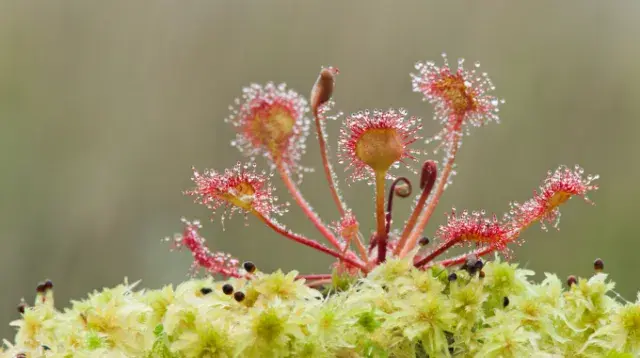Restoring English peatlands and their biodiversity
Although largely ignored in climate issues, peatlands are actually unparalleled carbon stores and havens of biodiversity. In the north of England, in the area around Manchester, The Wildlife Trust for Lancashire, Manchester and North Merseyside, has set to work on restoring them one by one. With the re-introduction of an endangered medicinal plant, the site at Little Woolden Moss will be restored further, thanks to support from the Klorane Botanical Foundation.
Precious peatlands in poor shape
They may only cover 3% of the planet’s land surface, but they store over 550 gigatonnes of carbon in their soil, that’s twice as much as the entire cumulative forest biomass. Less observed and less admired than tropical forests, they are every bit as good as them when it comes to biodiversity and ecosystem services. They are home to species that love these oxygen-poor environments – butterflies, lizards and grasshoppers, calluna heather and varieties of sphagnum moss, but also medicinal carnivorous plants, such as round-leaved sundew. Peatlands also play an essential role in the water cycle by regulating water flow in times of flood and filtering waters that passes through them.
However, peat ecosystems, these waterlogged areas, covered in mosses and grasses and rich in organic material, have already suffered from the serious repercussions of human activity. Misunderstood for too long and therefore undervalued, they have been drained, destroyed or urbanised, to the point that 97% of lowland English peatlands have now disappeared.

Bringing an entire ecosystem back to life
In the Manchester area, The Wildlife Trust for Lancashire, Manchester and North Merseyside, has been working tirelessly for over 20 years to restore peat ecosystems that have been damaged or have almost disappeared. Saved from destruction in the nick of time in 2012, peatland at Little Woolden Moss is on the path to recovery, thanks to the work of the organisation and the involvement of its volunteers. In the past, as peat was extracted from this 107 hectare site, it was therefore drained; now the project supporting further restoration on 35 hectares of the site will involve two stages. The first stage is work to rehydrate the peat – key to improving the hydrology of and condition of a peatland.
The work involves backfilling drainage ditches and using a technique called bunding (low walls of compacted peat) to overcome cracks and pipes in deep layers of peat, or to catch rainfall and slow the internal movement of water from the bog. The water held by the peat will gradually allow plant biodiversity to re-establish and organic material to stabilise and continue its role of storing carbon. Since extraction was stopped on Little Woolden Moss, typical bog species have started to return thanks to the WildlifeTrust and its restoration efforts, but this new stage of work is vital to help the full wealth of wildlife to return and the ecosystem service a healthy lowland peatland can provide.

To diversify the new inhabitants, a hundred plug plants are then going to be planted, prioritising the re-introduction of native varieties, including sundews, known for their medicinal properties and today considered an endangered species because of the loss of its habitat. The restoration of Little Woolden Moss should save 22.5 tonnes of carbon over the next 30 years. Above all, it will guarantee essential ecological continuity by increasing the density of the local peat ecosystem. Just opposite, its little sister Cadishead, a former peat extraction site already restored by The Lancashire Wildlife Trust, offers a vision of what the future will be like for Little Woolden Moss: a haven of greenery in a thousand hues, with dragonflies darting about and over 50 species of birds calling it home.
Restoring peat ecosystems is an essential component in safeguarding biodiversity and combating climate change. Neglected for far too long, peatlands are the best allies we have and they need all our attention. We are happy to have found in Klorane Botanical Foundation, a partner that is so involved in these issues, in particular, in the re-introduction of endangered species.
Notre partenaire
The Wildlife Trust for Lancashire, Manchester and North Merseyside is part of The Wildlife Trusts network, the largest wildlife conservation charity in the United Kingdom. Founded in 1962, the local organisation manages over 1300 hectares of nature reserves, with the help of its 140 employees and 1200 regular volunteers. Every year, it engages with over 20,000 children in its mission to raise awareness of environmental conservation.

